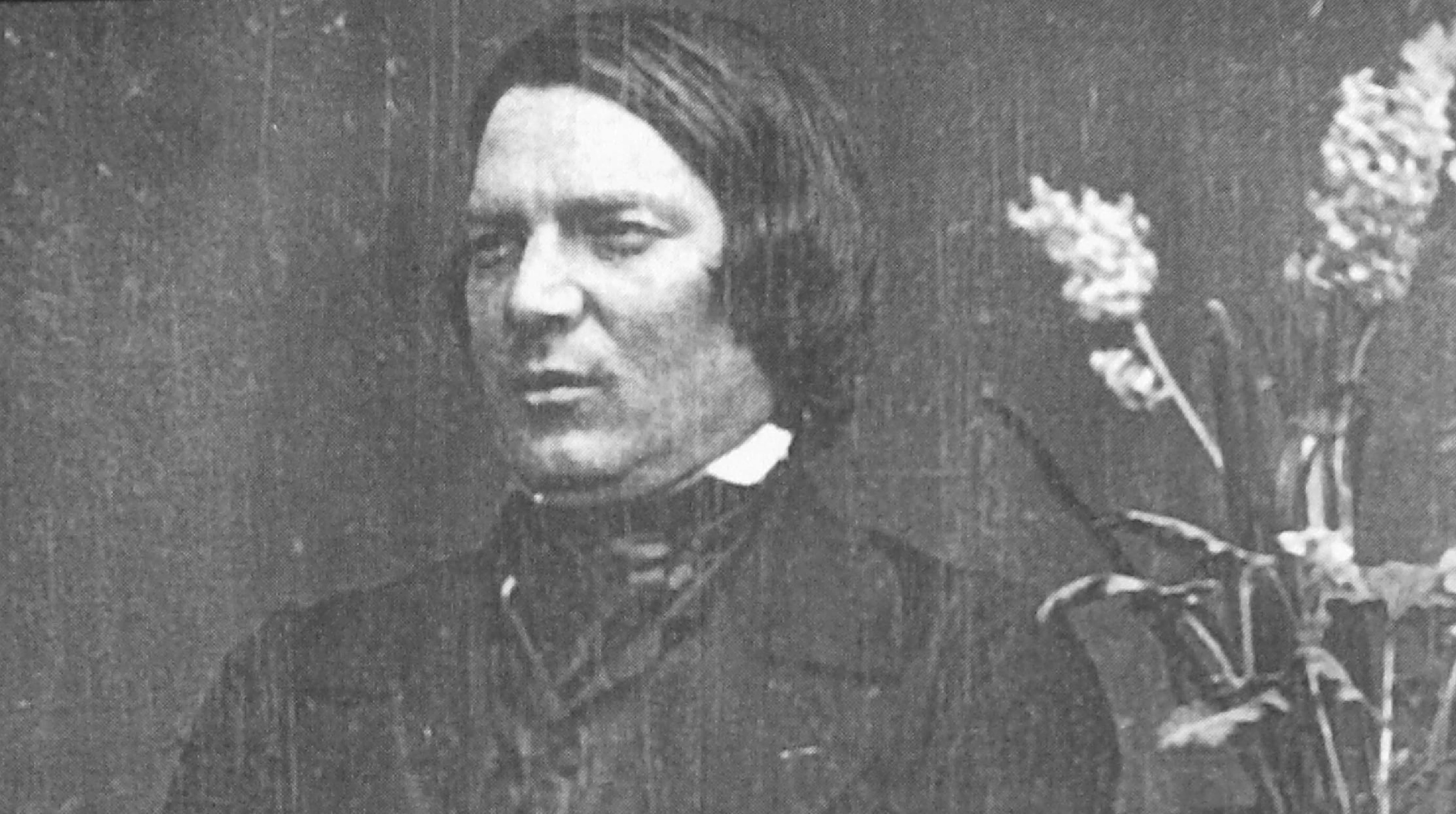Robert Schumann’s Symphony No. 4 in D minor begins with a bold announcement in the form of a single, multi-octave-deep “A”. It’s a musical “call to order” which seems to establish the blank, open-ended canvas on which the Symphony will develop. The first brushstroke to fall on this canvas is a descending motif which is the seed out of which the entire Symphony grows. This is the famous “Clara Theme” we explored in Monday’s post. In this Symphony, it becomes the equivalent of Berlioz’ idée fixe. Throughout the first movement’s slow, ominous introduction, this motif begins immediately to evolve and reach out of these initial shadowy, D minor depths. It is firmly embedded in the jumpy first theme of the exposition (Lebhaft). As the first movement unfolds, listen to the way this small motivic kernel is repeated with obsessive persistence.
The development section begins with a jarring, E-flat interruption. Throughout Schumann’s four symphonies you might notice echoes of Schubert’s monumental Ninth Symphony, a piece that Schumann discovered and promoted ten years after Schubert’s death. To my ears, this ever-intensifying sequential passage, with its bubbly arpeggios in the low strings, is one of these examples. In the middle of the development section, as the “Clara motif” continues to make its presence felt, a brand new, spirited theme takes shape in the winds and then is reaffirmed as a majestic statement by the full orchestra. The introduction of new themes at this point is a brash violation of typical sonata form, yet in this continuously developing movement it feels like an inevitable and thrilling arrival.
The four movements of Schumann’s Fourth Symphony flow together without interruption. The first movement’s final cadence leads directly into the second movement (Romanze: Ziemlich langsam). Here, we find ourselves in a more intimate, songlike world, with a lamenting melody in the solo oboe and cello and later, a wandering solo violin obbligato. The first three pitches of this melody make up the “Clara motif” in reverse. Brahms paid homage to this Romanze in the third movement of his Third Symphony, which opens with the same intervals. Notice the brief return of the solemn music from the first movement’s introduction. Within this Symphony’s cyclic form, there is no escaping the haunting Powers which lurk just beneath the surface and continue to reemerge.
The Scherzo is filled with gruff, jovial ferocity, interrupted only by the flowing repose of the trio section. Again, we hear the “Clara” theme in the melody’s opening four note ascending and descending lines. Notice the canonic conversation between the high and low strings. At the end of the movement, the trio section fades into the quiet mystery of the bridge which leads directly into the final movement. This is a nod to a similar moment in Beethoven’s Fifth Symphony. The “Clara motif” returns as a shadowy ghost while an ascending fragment of the motif emerges in the trombones.
The final movement erupts with euphoric joy and exhilarating forward momentum. In melodic contour of the second theme, I hear echoes of the third movement of Beethoven’s 9th Symphony. More obviously, there are references to the preceding movements (for example, this passage which rises in sequential steps corresponds to this moment at the end of the first movement). The music is still infused with the “Clara motif.” (Here, it becomes a celebratory statement in the horns). The exuberant coda section brings the Fourth Symphony’s continuous, cyclic drama to a thrilling conclusion.
Here is Wolfgang Sawallisch’s 1973 recording with the Staatskapelle Dresden:
A Symphony in Two Versions
The Fourth Symphony was actually the second symphony Schumann composed. The first version was written in the summer of 1841 and premiered on December 6 of that year with Ferdinand David leading the Leipzig Gewandhaus Orchestra. Ten years later, Schumann returned to the work and made revisions including orchestration and a change of meter in the first movement. This version was published as “Symphony No. 4.” Clara Schumann insisted that the earlier version was only a sketch and that the Symphony should be heard only in its later, more Romantic form. Brahms preferred the lighter original version and had it published in the 1880s over Clara’s strong objection.
Now that we’ve heard the Fourth Symphony in its more familiar form, let’s listen to Simon Rattle’s recording of the original 1841 version with the Orchestra of the Age of Enlightenment for comparison. I have played both versions of this piece and I still prefer the final version. In the comment thread below, let me know which is your favorite.
Five Great Recordings
- Schumann: Symphony No. 4 in D minor, Op. 120, Wolfgang Sawallisch, Staatskapelle Dresden Amazon
- Schumann: Symphony No. 4 in D minor (1841 version), Simon Rattle, Orchestra of the Age of Enlightenment Berlin Philharmonic Recordings
- Christoph von Dohnányi and the Cleveland Orchestra
- George Szell and the Cleveland Orchestra
- Yannick Nézet-Séguin and the Chamber Orchestra of Europe


Thanks a lot Timothy
I appreciate both versions, but I prefer the final one.
I wonder if Mahler thought of the Second Movement of Schumann’s Fourth when he came to compose the Third Movement of his own First Symphony: both feature the solo cello carrying the principal tune for their respective movements.
Of course, Mahler bothered to reorchestrate Schumann’s symphonies for concert performance, so obviously he was closely knowledgable about the music.
In the third movement of Mahler’s First Symphony, it’s actually the double bass which is in the spotlight.